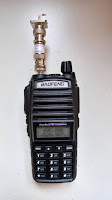 |
| UV-82 400 to 520 MHz |
That's nothing new, it's cheap and worth trying. So I rigged up the multiplier shown in the picture with an unknown Schottky diode.
The Baofeng UV-82 RTX transmits between 400 and 521 MHz; that's plenty of choice to get an harmonic show up in the GHz range.
In order to check if it works I first looked for the harmonic on 10 GHz through an LNB, and sure it was where expected.
Unfortunately I did not see (receive) anything on 24 GHz, even at the higher power setting of the UV-82 source.
 |
| A better view of the diode and adapters. |
Then I tried with a source that covers 2000 to 2990 MHz and there was no sign on 24 GHz while it was very strong on 10 GHz. I think the LNB amplification chain makes a lot of difference.
Still a 24 GHz module can receive another module at 12 metres distance with S9 and probably more once the antennas are properly aligned. I postpone the frequency measurement and spend time on checking which distance is possible in a radar-to-radar setup.



